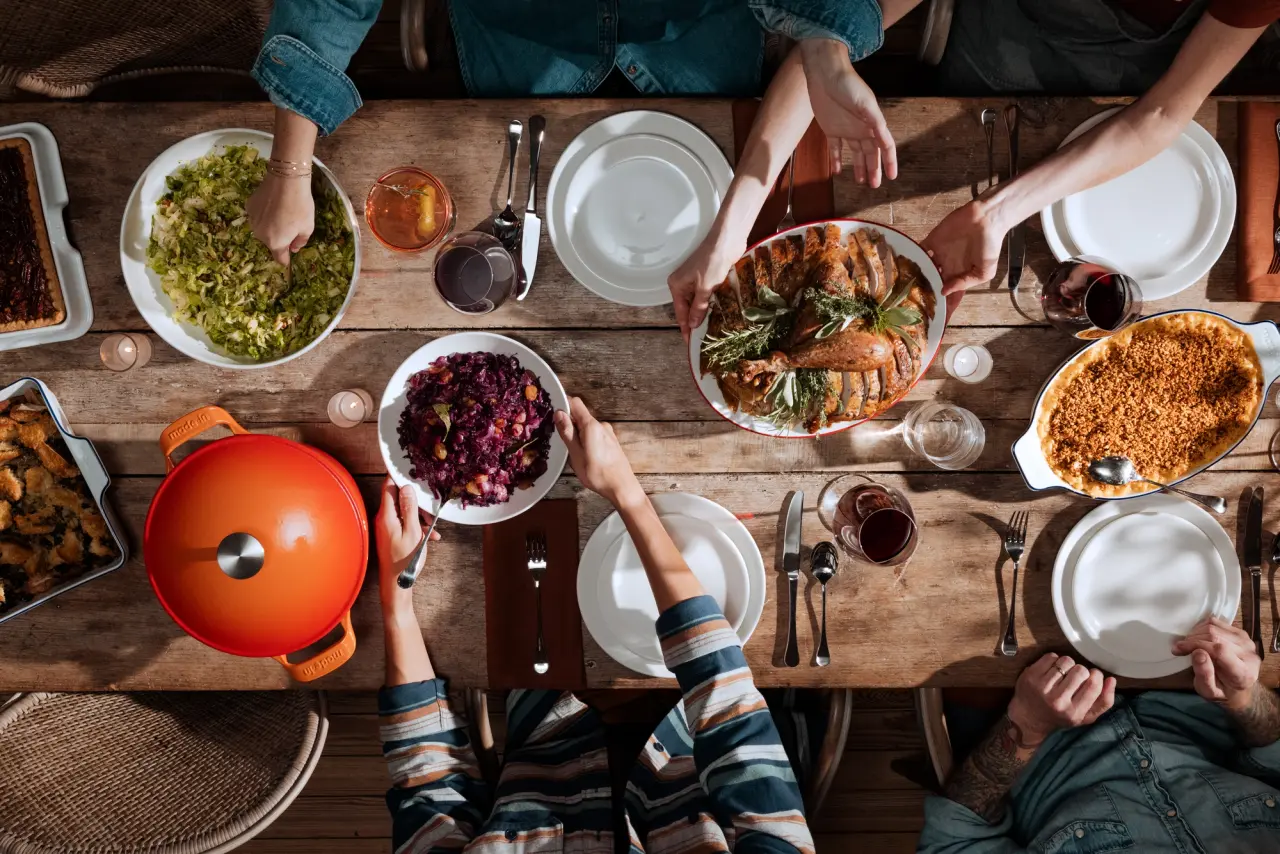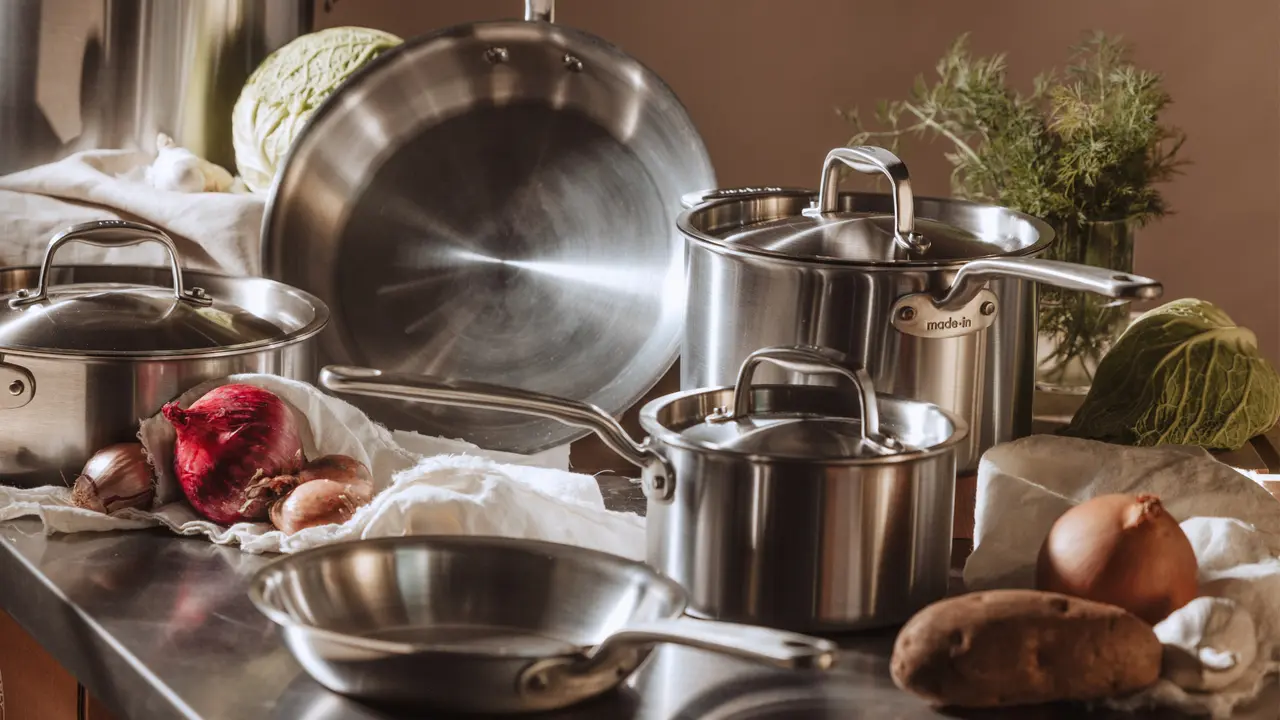Shopping for an everyday dinnerware set can be overwhelming. With a plethora of shapes, designs, colors, and materials, the choices can seem never-ending. However, with the proper guidance and information, this process can be a breeze, and that’s what we’re here for. Made In has put together a comprehensive guide to make your decisions easier. We’ll cover how many sets you should purchase for your dining room, the types of items you need, what materials are best, the design and functionality, what attributes are a must-have, and lastly, different ways to make the most of your new sets. Let’s dive in and talk about how to shop for dinnerware.
How Many Sets Should I Purchase?
This should probably be the first thing to consider when you’re shopping for a new everyday dinnerware set for your dining room. You should take note of the number of place settings sold in sets. There are commonly 4 or 6 place settings in dinnerware sets, but that can vary, so be sure to note that before you purchase. Formal dinnerware sets will most commonly include flatware and plateware for your dining table. The flatware set should consist of two sizes of spoons and forks, along with a knife. The plateware’s dish set should contain two different types of plates (dinner plate and appetizer plate), two different bowls (entrée bowl and side bowl), and, if you’re lucky, a serving platter. Here are a few more things to consider:
How Many People are in Your Family, and is it Growing?
- If you live by yourself or with someone else, anywhere from a 4-8 place dinner set makes sense (depending on how often you feel like doing the everyday dishes!). This gives you more than enough for you and your living mate.
- If you live with 4-6 people, an 8-12 place dinner set will work for your dining table.
- A good rule of thumb to follow is 2-3 place settings per person!
How Often do you Host People?
- There is nothing worse than having people over for a dinner party and realizing that you don’t have enough place settings or different types of drinking glasses, forcing you to break out the leftover paper plates and cups that came with your pizza delivery the previous week. Okay, maybe we’re exaggerating a bit, but still. If you host people, dinner parties, or your kids have friends over often, it is worth purchasing extra place settings.
If you do Host, do you Prefer Large Crowds or Small Crowds?
- Well, how many extra place settings? Great question. Depending on how many people you like to have for dinner parties, this number can vary. If you host large gatherings, you can double your dinnerware sets. If you host rarely or with a smaller crowd, only a few extra place settings are necessary.
Another thing to consider is that you don’t always have to buy dinnerware in sets. Purchasing individual pieces of cookware can give you more versatility with what pieces you can offer. If you find yourself making everyday meals that are more commonly served in bowls, it’s beneficial to stock your cupboards with a few extra bowls. Breaking up formal dinnerware sets and adding individual items to your collection should be one of the leading factors when you begin your search. Now that you know how much to buy, let’s get into what materials go into the production of your new dinnerware collection.
Finding the Best Materials
Plateware
What are the different types of plate materials is a commonly-asked question. Ceramic, stoneware, earthenware, porcelain, and many more make up the vast world of plate materials, and there are certainly differences among these.
Ceramic
Ceramic plateware is fired at an extremely high temperature for a long time. This process ensures long-lasting, durable plates, bowls, and serving platters that are also resistant to breakage. Ceramic plates can also be coated with a reactive glaze, which allows for hassle-free stacking and a scratch-free surface.
Stoneware
A durable stoneware dinnerware set is also made of clay but isn’t fired at as high a temperature as ceramic. It is more resistant to scratches than earthenware.
Earthenware
Earthenware is fired at the lowest temperature compared to a ceramic or stoneware set and is also porous, so water and bacteria can enter the dinner plate’s body. Earthenware can also feel a bit bulky.
Which Plateware Material is Best?
The best dinnerware material is ceramic. Ceramic is the most durable, especially if it’s fully vitrified. Vitrification is the process of heating plateware to its boiling point and then firing it in the kiln to give the surface of the plates a smooth, glasslike surface. This results in plateware that is extremely strong and way more resistant to bacteria. Fully vitrified plates are the gold standard in the hospitality industry, and you can now purchase them for your home.
Flatware
What is flatware? Think of all of the cutlery used during meals: forks, knives, and spoons. For flatware materials, you’ll mostly find stainless steel as the primary metal, with the addition of chromium and nickel for added strength and durability.
Two common compositions you’ll see for flatware are 18/10 and 18/0. The first number (in this case, 18) represents the amount of chromium present in the stainless steel, while the second number (in this case, 10 or 0) represents the amount of nickel present in the stainless steel. Chromium helps work against rust, while nickel helps keep the flatware shining by protecting against corrosion.
Forks and spoons should have 18/10, while knives commonly feature 18/0 because this gives them extra strength, which is necessary for cutting.
Aesthetics
How your plate looks and is designed is very important. Some people prefer more classic designs while others prefer modern, sleek designs. Whichever you prefer, it is essential to remember that the point of plateware is to serve food. You should choose plateware that allows the food to shine and be the star of the dish.
A simple decoration like a colored rim or a few lines along the inner curves of the bowl works great. Full bleed color plateware can also be used. However, once you get to busy artwork on the surface of the plate or bowl where the food would be plated, we believe it takes away from the dining experience.
For flatware, you want something that will feel balanced in your hand and not be too heavy or too light. You also want to have the option to dress it up or dress it down, so having a classic shape with a timeless feel is critical.
Attributes
Now that you have the number, type, and look of your plates figured out, it’s essential to understand what you want from your new collection.
When it comes to plateware, you want something that can be used without restrictions. All dinnerware pieces should be dishwasher safe, microwave safe, refrigerator and freezer safe, and lastly, oven safe.
The obvious microwave and dishwasher safe are quite customary when it comes to plateware. This leads to easy cleaning and hassle-free reheating of meals. It’s the three other attributes listed above that will allow you to take your everyday meals to the next level. If you can put your dishware in the refrigerator or freezer, then your food can stay at its intended temperature for a longer time. We love doing this for ice cream, ceviche, cold soup, and more! Simply place your piece in the fridge or freezer for 10 minutes before serving, and you’re good to go! The same method applies for the oven. Placing your plateware in a 300-degree oven for 10 minutes will warm up the plate and keep your food hotter for a longer time. Next time you’re searing a steak, roasting a chicken, or grill vegetables, serve them on a warm platter for a better dining experience. Having plateware with these attributes will instantly elevate all of your meals.
Made In’s Tabletop Collection
At Made In, we pride ourselves on making cookware, bakeware, and tabletop pieces from the world’s best artisans. Our tabletop collection pieces are made in Western Europe, with our plateware crafted in Stoke-on-Trent, England, and our flatware and glassware crafted in Italy. All of Made In’s plateware is high-alumina vitrified ceramics, making it one of the strongest and most durable plateware options on the market. Whether you want to buy in a large-format tabletop set or in a set of four, Made In has you covered with the best dinnerware sets for everyday use. So the next time you’re looking to upgrade your tabletop pieces, or you’re looking to buy for the first time, choose plateware and flatware that is up for any task and will be at the center of your favorite meals and memories.





















